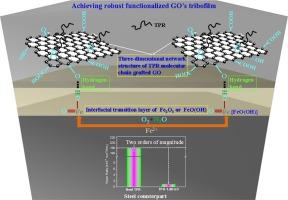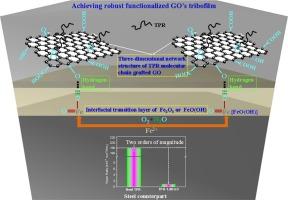氧化石墨烯分子组装用于热塑性酚醛树脂纳米复合材料中的自愈合润滑结构
IF 6.9
2区 材料科学
Q2 CHEMISTRY, PHYSICAL
引用次数: 0
摘要
尽管氧化石墨烯(GO)在聚合物复合材料中具有优异的润滑性,但由于纳米填料具有很强的 π-π 相互作用,且与基体的界面相容性较差,其摩擦学潜力的充分发挥仍然受到纳米填料聚集的限制。为了应对这些挑战,我们提出了一种分子组装策略,通过苯酚单体与预接枝的 GO 纳米片的原位聚合,在热塑性酚醛树脂(TPR)中实现了原子级均匀分散的 GO,通过 GO 的含氧基团(-COOH、-OH)和酚醛 -OH 基团之间的共价键克服了聚集问题。值得注意的是,仅 0.5 wt% 的 GO 就能将摩擦系数降低 50%(从 0.4 降至 0.2),而植入 1.0 wt% 的 GO 则能将干摩擦中与轴承钢滑动时的磨损率降低 2 个数量级以上(从 1.8 × 10-5 mm3/Nm 降至 1.2 × 10-7 mm3/Nm)。研究结果表明,GO 纳米片在滑动界面上发生了摩擦化学反应,形成了坚固的纳米润滑三膜,厚度约为 150 nm,由与羟化铁(FeOOH)化学锚定的排列整齐的 GO 层组成。这种界面结构增强了三膜的坚固性和自修复能力,从而极大地提高了纳米复合材料的耐磨性。本文章由计算机程序翻译,如有差异,请以英文原文为准。


Molecular assembly of graphene oxide for self-healing lubrication architectures in thermoplastic phenolic resin nanocomposites
Despite the exceptional lubricity of graphene oxide (GO) for polymer composites, achieving its full tribological potential remains constrained by nanofiller aggregation due to the strong π-π interactions and poor interfacial compatibility with the matrices. To address these challenges, a molecular assembly strategy was proposed and hence an atomic-level uniformly dispersed GO in thermoplastic phenolic resin (TPR) was achieved through an in-situ polymerization of phenol monomers with pre-grafted GO nanosheets, overcoming aggregation via covalent bonding between GO’s oxygen-containing groups (–COOH, –OH) and phenolic –OH groups. Remarkably, incorporating just 0.5 wt% GO reduced the friction coefficient by 50 % (from 0.4 to 0.2) and implanting 1.0 wt% GO decreased the wear rate by more than 2 orders of magnitude (from 1.8 × 10−5 mm3/Nm to 1.2 × 10−7 mm3/Nm) when sliding against bearing steel in dry friction. It was attributed that GO nanosheets underwent tribochemistry at the sliding interface, forming a robust nano-lubricity tribofilm with a thickness of about 150 nm and composed of aligned GO layers chemically anchored with hydroxylated iron (FeOOH). This interfacial architecture enhanced the tribofilm’s robustness and self-healing capacity, therefore improving wear resistance of the nanocomposites extraordinarily.
求助全文
通过发布文献求助,成功后即可免费获取论文全文。
去求助
来源期刊

Applied Surface Science
工程技术-材料科学:膜
CiteScore
12.50
自引率
7.50%
发文量
3393
审稿时长
67 days
期刊介绍:
Applied Surface Science covers topics contributing to a better understanding of surfaces, interfaces, nanostructures and their applications. The journal is concerned with scientific research on the atomic and molecular level of material properties determined with specific surface analytical techniques and/or computational methods, as well as the processing of such structures.
 求助内容:
求助内容: 应助结果提醒方式:
应助结果提醒方式:


